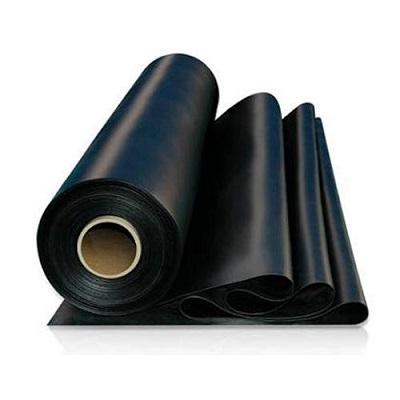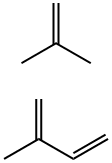-
解説
ブチルゴム不飽和結合が少ないので,熱,酸素,オゾン,薬品に対する抵抗力が大きく,ガスおよび空気の透過性が小さいが,機械的強度はあまり大きくなく弾性も低い.
-
製造
ブチルゴム略称IIR.0.5~4物質量% のイソプレンを含むイソブテンの共重合体で,塩化アルミニウムを触媒として,-100 ℃ 付近の低温でつくられる.
-
主な用途/役割
イソブチレンとイソプレンとを重合させて得られる合成ゴム。布、プラスチックフィルム、紙、発泡体のようなフレキシブルなものを接着する接着剤、木材用水系高分子イソシアネート系接着剤に使用される。
-
説明
A synthetic copolymer containing from 0.5 to 2.0 molar percent
of isoprene, the remainder, respectively, consisting of isobutylene.
It is prepared by copolymerization of isobutylene and isoprene in
methyl chloride solution, using aluminum chloride as the catalyst.
After completion of polymerization, the rubber particles aretreated with hot water containing a suitable food-grade deagglomerating agent, such as stearic acid. Finally, the coagulum is dried
to remove residual volatiles.
-
化学的特性
Butyl rubber has the chemical resistance characteristic of
saturated hydrocarbons. Oxidative degradation is slow, and
the rubber may be further protected by incorporating antioxidants.
Isobutylene is the major component of bulk rubber.
It provides good aging resistance and low gas permeability.
Isoprene, a minor component, enhances vulcanizability.
-
使用
Butyl rubber is formed from the polymerization of isobutene (isobutylene) with small amounts of chloroprene, isoprene, or butadiene and may be halogenated. The reaction is carried out in a closed system with an aluminum chloride catalyst. Butyl rubber is highly impervious to gases, which makes it the rubber best suited for inner tubes and tires, air chambers, adhesives, and dielectrics. Isobutene is an anesthetic and asphyxiant gas and can be hazardous in concentrations high enough to produce asphyxia. At these concentrations, explosion is an additional hazard.

-
製造方法
Commercial butyl rubbers generally contain 1-3 mole % isoprene. In a
typical process, a solution of the monomers in methyl chloride is pre-cooled
to -lOO??C and then fed continuously into the base of a reactor together with
a solution of aluminium chloride (initiator) in the same diluent. The reaction
is highly exothermic and in order to maintain the temperature at -100??C the
reactor is fitted with a powerful stirrer and cooling coils containing liquid
ethylene. The polymer forms as a granular slurry which is displaced continuously from the top of the reactor. The slurry passes into a flash tank
where it is vigorously agitated with hot water. This treatment deactivates the
initiator and extracts water-soluble products. At the same time the diluent
and unreacted monomers are flashed off and are purified and re-used. Also at
this point a lubricant and an antioxidant are introduced into the polymer.
The lubricant, usually zinc stearate, prevents agglomeration of wet crumb
and the antioxidant, usually phenyl-p-naphthylamine, reduces degradation
during drying operations. The slurry then passes to a screen where wet
polymer crumb is isolated. The crumb is dried at about 95-170??C, fed
through an extruder and then hot milled. The object of these last operations
is to compact the polymer and remove all traces of residual water.
In butyl rubber the isoprene is present as random l,4-units and the
copolymer thus has the following form:

-
調製方法
The bulk of butyl rubber is made by a slurry process using
aluminum chloride at 98–99°C and methyl chloride as a diluent. The extremely rapid reaction is unique, and proceeds
via cationic polymerization to completion at 100°C in less
than a second. Butyl rubber may be vulcanized by three basic
methods: accelerated sulfur vulcanization, cross-linking
with dioxime and related dinitroso compounds, and polymethylol–
phenol resin cure. Halogenated butyl rubber
allows broadened vulcanization latitude and rate, and
enhanced covulcanization to general-purpose elastomers
while it maintains the unique attributes of the basic butyl
molecule.
-
欠点と対策
ブチルゴムは、弾性や加工性、耐油性の点では天然ゴムに劣り、他の合成ゴムとの相溶性が悪いため混合して新たな機能を有するゴム素材を開発することも難しいです。 このようなデメリットを解消するため、合成時のイソプレン量をコントロールすることで不飽和度を変更したり、粘度調整や老化防止剤の添加によってさまざまな種類のブチルゴムが合成されています。
ブチルゴムは加硫速度が遅く、他の高度不飽和ゴムと共加硫がしにくく、また、他のゴムや金属との接着性が悪いという特徴があります。この欠点を克服するために、ブチルゴム分子に塩素原子、臭素原子を導入したハロゲン化ブチルゴムが開発されました(図2)。これらのハロゲン化ブチルゴムは、分子内に反応性の高いハロゲン分子および二重結合を含むことから、一般的なブチルゴムよりも加硫速度が速く、その加硫度も大きい事が報告されています。
-
使用用途
ブチルゴムの使用用途は多岐に渡ります。メインは自動車分野で、タイヤチューブ、ホース、ベルトなどの原料として使用されています。その他の工業製品としては、電線の被覆材、窓枠のゴム、スポーツで使用されるサッカーボールやバスケットボールなどに使用されています。製品の傾向を見ると、引っ張られたり、衝撃が強く、摩耗が激しい箇所などに使用されており、特に一定以上の強度が必要である製品に応用されています。
-
工業用途
Butyl rubbers have outstanding impermeabilityto gases and excellent oxidation andozone resistance. The chemical inertness is furtherreflected in lack of molecular-weightbreakdown during processing, thus permittingthe use of hot-mixing techniques for betterpolymer/filler interaction.
-
概要
ブチルゴムとはイソブチレンにを共重合して調製された合成ゴムの1種であり、我々の身の回りの製品に使用されています。その構造は図1の通りであり、1937年にアメリカのスタンダード・オイル社で石油を原料として初めて開発され、その後日本でも生産が開始されました。添加剤の付与などによってブチルゴムにはさまざまな種類があり、使用する製品特性に合わせて最適なブチルゴムが生産されています。
-
特徴
ブチルゴムの合成方法はイソブチレンにイソプレンを添加し、共重合により作られます。このゴムに特に有用な性質の一つが耐空気透過性であり、その割合はやスチレンゴム、ブタジエンゴムと比較すると約10分の1程度となります。この空気を透過させない性質により、ゴム内部に空気を貯め、外部へ透過による流出を抑えておきたいタイヤやボールなどに最適な原料となります。他にも、ブチルゴムは、耐熱性、耐老化性、耐薬品性、耐酸・アルカリ性、電気絶縁性に非常に優れており、以下のように多用な用途で用いられています。
- 耐熱性を期待した用途
コンデンサーのパッキン、スチームホースの素材
- 耐候性、耐老化性を期待した用途
建築用の防水素材、廃棄物処理池用のシート、
- 耐薬品性、耐酸・アルカリ性を期待した用途
医薬品用のゴム栓、、ゴムホース、工業用品
- 電気絶縁性を期待した用途
電線被覆、
- 耐空気透過性を期待した用途
タイヤ、スポーツ用のボール
-
Advantages
Butyl rubber is chemically resistant to non-oxidizing dilute mineral acids, salts and alkalis, and a good chemical resistance to concentrated acids, except sulfuric and nitric acids. Moreover, it has a low permeability to air and an excellent resistance to aging and ozone. However, it is readily attacked by oxidizing chemicals, oils, benzene, and ketones and as a general rule it has also poor chemical resistance to petroleum and its derivatives and many organic chemicals. Moreover, butyl rubbers are sensitive to UV-irradiation (e.g., sunlight exposure). As with other rubbers, its mechanical properties can be largely improved by the vulcanization process.


